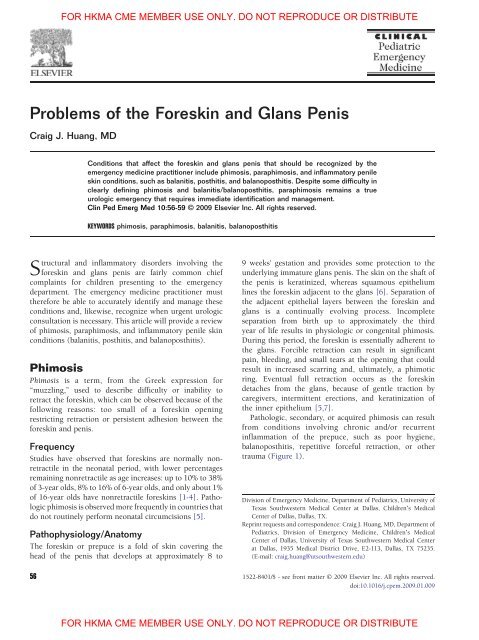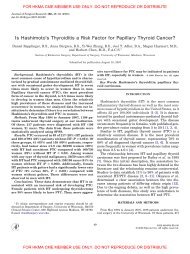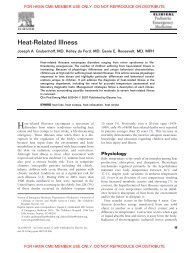Problems of the Foreskin and Glans Penis - Hkmacme.org
Problems of the Foreskin and Glans Penis - Hkmacme.org
Problems of the Foreskin and Glans Penis - Hkmacme.org
- No tags were found...
You also want an ePaper? Increase the reach of your titles
YUMPU automatically turns print PDFs into web optimized ePapers that Google loves.
FOR HKMA CME MEMBER USE ONLY. DO NOT REPRODUCE OR DISTRIBUTE<strong>Problems</strong> <strong>of</strong> <strong>the</strong> foreskin <strong>and</strong> glans penis57patients who fail steroid <strong>the</strong>rapy or those with pathologicphimosis, painful erections, recurrent urinary tract infections,or balanoposthitis, a urologic consultation forcircumcision is recommended [8,14].ParaphimosisParaphimosis is a urologic emergency in which <strong>the</strong>foreskin is irreducibly retracted over <strong>the</strong> glans penis,with resultant distal swelling <strong>and</strong>, ultimately, ischemicsymptoms if <strong>the</strong> entrapped prepuce cannot be returned toits proper position (Figure 2).Figure 1 Pathologic phimosis resulting from inflammation <strong>of</strong> <strong>the</strong>foreskin (posthitis).SymptomsPatients with congenital phimosis should be asymptomatic.Desquamated epi<strong>the</strong>lial cells, trapped under <strong>the</strong>foreskin near <strong>the</strong> corona <strong>of</strong> <strong>the</strong> glans penis, or smegma canbe observed in children with an incomplete foreskinretraction. These benign whitish lumps or discharge willextrude once complete retraction <strong>of</strong> <strong>the</strong> foreskin takesplace. Pathologic phimosis may be accompanied bydifficulty with urination or alteration <strong>of</strong> <strong>the</strong> urinary stream.“Ballooning” or bulging <strong>of</strong> <strong>the</strong> prepuce from urinetemporarily trapped in <strong>the</strong> subpreputial space resultsfrom a very tight phimosis with a narrow opening. Dysuriaor hematuria can occur, though less commonly [7,8]. Ifuntreated, phimosis can ultimately lead to chronicinflammation, carcinoma, painful intercourse, or paraphimosis.Paraphimosis occurs when <strong>the</strong> phimotic foreskin isretracted over <strong>the</strong> glans penis <strong>and</strong> cannot be reduced backinto its original position.TreatmentBecause most children will have retractile foreskins asteenagers, “watchful waiting” <strong>and</strong> continued properpreputial hygiene is <strong>the</strong> optimal treatment strategy forthose patients with physiologic phimosis [4,8]. Timely <strong>and</strong>proper retraction <strong>of</strong> <strong>the</strong> foreskin should not be forceful orproduce pain based on <strong>the</strong> age-dependent pathophysiology<strong>and</strong> potential complications described above. Topicalcorticosteroids may be used to hasten this process. Theyhave been demonstrated to be perhaps a safer, moreeffective, <strong>and</strong> economical alternative <strong>the</strong>rapy for phimosisvs circumcision [5,9,10] or a prepuce-sparing surgicalprocedure, preputioplasty [11]. There is, however, greatvariability in <strong>the</strong> recurrence rate <strong>of</strong> phimosis with topicalsteroid use [5,12,13]. The most effective duration fortopical steroid application <strong>and</strong> <strong>the</strong> criteria used to definefailure <strong>of</strong> medical <strong>the</strong>rapy are as yet undefined [3]. ForFrequencyParaphimosis occurs in uncircumcised or incompletelycircumcised individuals <strong>and</strong> can occur at any age but ismost common in adolescence. A retrospective survey <strong>of</strong>caregivers <strong>of</strong> children attending 2 inner-city primary careclinics described 2 cases <strong>of</strong> paraphimosis <strong>of</strong> 272 (0.7%)uncircumcised boys [15]. There is also a significantiatrogenic incidence <strong>of</strong> paraphimosis, as when a child isca<strong>the</strong>terized to obtain a sterile urine sample <strong>and</strong> <strong>the</strong> careprovider subsequently neglects to reduce <strong>the</strong> foreskin.PathophysiologyOnce <strong>the</strong> foreskin is retracted behind <strong>the</strong> glans penis <strong>and</strong>not returned to its original position, distal vasculareng<strong>org</strong>ement <strong>and</strong> edema occurs at <strong>the</strong> glans <strong>and</strong> prepuce.Some reports have described an increased risk <strong>of</strong>paraphimosis in adults <strong>and</strong> teenagers with a history <strong>of</strong>repetitive urinary ca<strong>the</strong>terization, poor hygiene, penilebody piercing [16,17], <strong>and</strong> “erotic” dancing [18].SymptomsPatients can present with penile pain, but not always[19]. Painful erections have also been described. Childrenmay also present with obstructive voiding symptoms,dysuria <strong>and</strong> hematuria, <strong>and</strong> acute urinary obstruction ifFigure 2 Paraphimosis without evidence <strong>of</strong> ischemia to <strong>the</strong>foreskin or glans.FOR HKMA CME MEMBER USE ONLY. DO NOT REPRODUCE OR DISTRIBUTE
FOR HKMA CME MEMBER USE ONLY. DO NOT REPRODUCE OR DISTRIBUTE58 C.J. Huangdescribe involvement <strong>of</strong> both <strong>the</strong> foreskin <strong>and</strong> glans penis.Posthitis is <strong>the</strong> term used to describe specific involvement<strong>of</strong> <strong>the</strong> foreskin <strong>and</strong> balanitis, <strong>of</strong> only <strong>the</strong> glans penis.Balanitis xerotica obliterans is a more rare, chronic,progressive fibrosis <strong>of</strong> <strong>the</strong> foreskin <strong>of</strong> unknown etiology.Also called lichen sclerosus et atrophicus <strong>of</strong> <strong>the</strong> glanspenis, it can result in phimosis, sclerosis <strong>of</strong> <strong>the</strong> glans, <strong>and</strong>urethral stenosis. It should be considered in <strong>the</strong> differentialdiagnosis <strong>of</strong> school-aged children presenting with pathologicphimosis [27-30].Figure 3 Demonstration <strong>of</strong> <strong>the</strong> aspiration puncture method forparaphimosis reduction.<strong>the</strong> paraphimosis has been long st<strong>and</strong>ing <strong>and</strong> <strong>the</strong> swellingis severe.TreatmentThe goal <strong>of</strong> treatment <strong>of</strong> paraphimosis is to reduce penileedema enough to allow <strong>the</strong> foreskin to return to its originalposition over <strong>the</strong> glans. A variety <strong>of</strong> reduction techniqueshave been described, but controlled trials comparing <strong>the</strong>irefficacies have not been conducted [20,21]. All <strong>the</strong>techniques may require a regional anes<strong>the</strong>tic block,procedural sedation, <strong>and</strong>/or analgesia.Manual reduction entails steady circumferential pressureon <strong>the</strong> distal edema with countertraction on <strong>the</strong>foreskin, which can be facilitated with ice <strong>and</strong> sequentialwrapping. In addition, <strong>the</strong> use <strong>of</strong> gauze to provide greatertraction on <strong>the</strong> foreskin may be helpful [22].Osmotic methods with a variety <strong>of</strong> substances, includingsugar <strong>and</strong> hyaluronidase, have been described, especiallyfor those that have failed manual traction [22,23]. Thedisadvantage to <strong>the</strong> osmotic method is <strong>the</strong> longer time toachieve reduction compared with o<strong>the</strong>r techniques.Aspiration puncture methods, one <strong>of</strong> which wasoriginally described as <strong>the</strong> Dundee-Perth technique,involve expressing fluid from multiple puncture holessterilely placed in <strong>the</strong> edematous foreskin after a regionalpenile anes<strong>the</strong>sia [24,25] (Figure 3). Ano<strong>the</strong>r relatedmethod involves aspirating <strong>the</strong> glans [26].When less invasive techniques have failed to reduce <strong>the</strong>paraphimosis, a dorsal slit incision may be performed toalleviate <strong>the</strong> constricting ring [16]. Although this is a reliablemethod for reduction, <strong>the</strong> result may be cosmetically unsatisfactory,especially if circumcision is not desired. A circumcisionis ultimately <strong>the</strong> method used to alleviate o<strong>the</strong>rwiseirreducible paraphimosis <strong>and</strong> to prevent future recurrence.Balanitis, Posthitis, <strong>and</strong>BalanoposthitisBalanitis, posthitis, <strong>and</strong> balanoposthitis are states <strong>of</strong>inflammation or infection involving various parts <strong>of</strong> <strong>the</strong>foreskin <strong>and</strong> glans penis. Balanoposthitis is <strong>the</strong> term used toFrequencyBalanoposthitis occurs most <strong>of</strong>ten in children between <strong>the</strong>ages <strong>of</strong> 2 <strong>and</strong> 5 years [31,32]. European studies observethat no more than 4% <strong>of</strong> boys are affected [32]. Difficulty indetermining its true incidence may be a result <strong>of</strong>inconsistencies in diagnosis <strong>and</strong> lack <strong>of</strong> a clear definition.For example, is an irritant dermatitis in <strong>the</strong> diaper area thathas spread to <strong>the</strong> glans penis considered balanitis?Moreover, significant controversy exists regarding whe<strong>the</strong>r<strong>the</strong> presence or absence <strong>of</strong> <strong>the</strong> foreskin provides anincreased risk for penile inflammation. Van Howe [33]found that circumcised boys had an approximately 8-foldrisk <strong>of</strong> penile inflammation when adjusted for age youngerthan 3 years <strong>and</strong> number <strong>of</strong> examinations. The retrospectivesurvey <strong>of</strong> Herzog <strong>and</strong> Alvarez [15] reportedbalanitis in 5.9% <strong>of</strong> uncircumcised <strong>and</strong> 2.9% <strong>of</strong> circumcisedchildren, although <strong>the</strong> difference was not statisticallysignificant. Fergusson et al [34] found more penileproblems in circumcised boys younger than 1 year <strong>and</strong><strong>the</strong> reverse for patients older than a year.SymptomsPatients may complain <strong>of</strong> a wide variety <strong>of</strong> symptomsincluding penile itching <strong>and</strong> pain, redness, soreness,preputial discharge, <strong>and</strong> slight swelling [31]. Patientswith balanitis xerotica obliterans develop a distal preputialorificial white ring <strong>of</strong> scar tissue that ultimately results inpathologic phimosis, painful erections, <strong>and</strong> possibleurinary spraying <strong>and</strong> retention in later stages [28].Etiology/PathophysiologyThe etiology <strong>of</strong> balanoposthitis is most commonlynonspecific. It may be <strong>the</strong> result <strong>of</strong> inadequate hygiene <strong>of</strong><strong>the</strong> preputial-glanular sulcus, a contact dermatitis fromsoaps, detergents, clothing, or o<strong>the</strong>r external irritants, oreven excessive foreskin manipulation, so-called foreskinfiddling [28,31,32,35]. Infectious agents have also beenimplicated as possible etiologies for balanoposthitis:streptococcal <strong>and</strong> staphylococcal species [8,28] <strong>and</strong>c<strong>and</strong>ida [33]. In one series, 100 consecutive boys aged 2to 9 years were seen in follow-up at a urology clinic. Thirtytwo<strong>of</strong> <strong>the</strong>se patients had initially presented to <strong>the</strong>emergency department, <strong>and</strong> cultures <strong>of</strong> preputial dischargein <strong>the</strong>se patients revealed 15 with no growth, 7 with mixedFOR HKMA CME MEMBER USE ONLY. DO NOT REPRODUCE OR DISTRIBUTE
FOR HKMA CME MEMBER USE ONLY. DO NOT REPRODUCE OR DISTRIBUTE<strong>Problems</strong> <strong>of</strong> <strong>the</strong> foreskin <strong>and</strong> glans penis59growth, 5 with Staphylococcus aureus, 4 with Proteusvulgaris, <strong>and</strong> 1 with M<strong>org</strong>anella m<strong>org</strong>anii [32]. Distinguishingpossible infectious causes from those conditionscaused by sexually transmitted illnesses, Neisseria gonorrhoeae,Chlamydia trachomatis, Trichomonas vaginalis, <strong>and</strong>syphilis, is critical, especially in <strong>the</strong> prepubescent childwho may be <strong>the</strong> victim <strong>of</strong> sexual abuse. A variety <strong>of</strong> o<strong>the</strong>rinfectious etiologies <strong>and</strong> systemic diseases causing balanoposthitishave been observed in adult patients.Management/TherapyGeneral management usually involves careful cleansing <strong>of</strong><strong>the</strong> foreskin, sitz baths, <strong>and</strong> application <strong>of</strong> low-dose topicalcorticosteroids. Fur<strong>the</strong>r recommendations include irrigatingusing a small angioca<strong>the</strong>ter if <strong>the</strong>re is difficulty or painwith foreskin retraction, avoiding soap to clean <strong>the</strong> areabecause its use can alter <strong>the</strong> normal flora, <strong>and</strong> allowing <strong>the</strong>area to dry completely to discourage <strong>the</strong> growth <strong>of</strong> yeast. Ifc<strong>and</strong>idal or <strong>the</strong> rare bacterial infection is suspected, topicalantifungals or antibiotics can also be prescribed, with <strong>the</strong>addition <strong>of</strong> oral antimicrobials if <strong>the</strong>se <strong>the</strong>rapies are notsuccessful [28,33]. No evidence-based comparisonsbetween local foreskin care with oral <strong>and</strong> topicalantibacterial <strong>and</strong>/or antifungal treatments have beenconducted so <strong>the</strong>re is wide variability in practice.Circumcision, or an alternative preputial surgicalprocedure, is an option for recurrent episodes <strong>of</strong> balanitisrefractory to medical management <strong>and</strong> is <strong>the</strong> treatment <strong>of</strong>choice for balanitis xerotica obliterans.SummaryMost conditions affecting <strong>the</strong> foreskin <strong>and</strong> glans penispresenting to <strong>the</strong> emergency department are not serious orlife threatening <strong>and</strong> can be treated with topical antibioticsor corticosteroids, appropriate anticipatory guidance, <strong>and</strong>education regarding <strong>the</strong> normal development <strong>of</strong> <strong>the</strong>foreskin, as well as training in proper foreskin hygiene.Proper recognition <strong>and</strong> timely treatment <strong>of</strong> paraphimosisremains a paramount concern.References1. Øster J. Fur<strong>the</strong>r fate <strong>of</strong> <strong>the</strong> foreskin. Arch Dis Child 1968;43:200-4.2. Gairdner D. The fate <strong>of</strong> <strong>the</strong> foreskin, a study <strong>of</strong> circumcision. Br Med J1949;2:1433-7.3. Yang SSD, Tsai YC, Wu CC, et al. Highly potent <strong>and</strong> moderatelypotent topical steroids are effective in treating phimosis: a prospectiver<strong>and</strong>omized study. J Urol 2005;173:1361-3.4. Kayaba H, Tamura H, Kitajama S, et al. Analysis <strong>of</strong> shape <strong>and</strong> retractability<strong>of</strong> <strong>the</strong> prepuce in 603 Japanese boys. J Urol 1996;156:1813-5.5. Orsola A, Caffaratti J, Garat JM. Conservative treatment <strong>of</strong> phimosisin children using a topical steroid. Urology 2000;56:307-10.6. Lawless MR, Serwint JR. In brief: <strong>the</strong> foreskin. Pediatr Rev 2006;27:477-8.7. McGregor TB, Pike JG, Leonard MP. Pathologic <strong>and</strong> physiologicphimosis. Can Fam Physician 2007;53:445-8.8. Simpson ET, Baraclough P. The management <strong>of</strong> <strong>the</strong> paediatricforeskin. Aust Fam Physician 1998;27:381-3.9. Lund L, Wai KH, Mui LM, et al. An 18-month follow-up study afterr<strong>and</strong>omized treatment <strong>of</strong> phimosis in boys with topical steroid versusplacebo. Sc<strong>and</strong> J Urol Nephrol 2005;39:78-81.10. Palmer LS, Palmer JS. The efficacy <strong>of</strong> topical betamethasone fortreating phimosis: a comparison <strong>of</strong> two treatment regimens. Urol2008;72:68-71.11. Van Howe RS. Cost-effective treatment <strong>of</strong> phimosis. Pediatrics 1998;102:e43.12. Ku WH, Chiu BS, Huen KF. Outcome <strong>and</strong> recurrence in treatment <strong>of</strong>phimosis using topical betamethasone in children in Hong Kong.J Paediatr Child Health 2007;43:74-9.13. Zampieri N, Corropolo M, Zuin V, et al. Phimosis <strong>and</strong> topical steroids:new clinical findings. Pediatr Surg Int 2007;23:331-5.14. Esposito C, Centonze A, Alicchio F, et al. Topical steroid applicationversus circumcision in pediatric patients with phimosis: aprospective r<strong>and</strong>omized placebo controlled trial. World J Urol 2008;26:187-90.15. Herzog LW, Alvarez SR. The frequency <strong>of</strong> foreskin problems inuncircumcised children. Am J Dis Child 1986;140:254-6.16. Hansen RB, Olsen LH, Langkilde NC. Piercing <strong>of</strong> <strong>the</strong> glans penis.Sc<strong>and</strong> J Urol Nephrol 1998;32:219-20.17. Jones SA, Flynn RJ. An unusual (<strong>and</strong> somewhat piercing) cause <strong>of</strong>paraphimosis. Br J Urol 1996;78:803-4.18. Ramdass MJ, Naraynsingh V, Kuruvilla T, et al. Case report:paraphimosis due to erotic dancing. Trop Med Int Health 2000;5:906-7.19. Choe J. Paraphimosis: current treatment options. Am Fam Phys 2000;62:2623-8.20. Mackway-Jones K, Teece S. Ice, pins, or sugar to reduce paraphimosis.Emerg Med J 2004;21:77-8.21. Little B, White M. Treatment options for paraphimosis. Int J ClinPract 2005;59:591-3.22. Trainor JL. Paraphimosis reduction. In: Goodman DM, Green TP,Unti SM, Powell EC, editors. Current procedures: pediatrics. NewYork (NY): McGraw Hill Medical; 2007. pp. 145-7.23. Kerwat R, Sh<strong>and</strong>all A, Stephenson B. Reduction <strong>of</strong> paraphimosis withgranulated sugar. Br J Urol 1998;82:755.24. DeVries CR, Miller AK, Packer MG. Reduction <strong>of</strong> paraphimosis withhyaluronidase. Urology 1996;48:464-5.25. Reynard JM, Barua JM. Reduction <strong>of</strong> paraphimosis <strong>the</strong> simple way—<strong>the</strong> Dundee technique. Br J Urol Int 1999;83:859-60.26. Kumar V, Javle P. Modified puncture technique for reduction <strong>of</strong>paraphymosis. Ann R Coll Surg Engl 2001;83:126-7.27. Gargollo PC, Kozakewich HP, Bauer SB, et al. Balanitis xeroticsobliterans in boys. J Urol 2005;174:1409-12.28. Clark C, Huntley JS, Munro FD, Wilson-Storey D. Managing <strong>the</strong>paediatric foreskin. Practitioner 2004;248:888, 891-892, 894.29. Statement from <strong>the</strong> British Association <strong>of</strong> Paediatric Urologists onbehalf <strong>of</strong> <strong>the</strong> British Association <strong>of</strong> Paediatric Surgeons <strong>and</strong> TheAssociation <strong>of</strong> Paediatric Anaes<strong>the</strong>tists. Available at: http://www.apagbi.<strong>org</strong>.uk/docs/circumcision2007.pdf. Accessed 2/8/09.30. Yardley IE, Cosgrove C, Lambert AW. Paediatric preputial pathology:are we circumcising enough? Ann R Coll Surg Engl 2007;89:62-5.31. Schwartz RH, Gil RH. Acute balanoposthitis in young boys. PediatrInfect Dis J 1996;15:176-7.32. Escala JM, Rickwood AMK. Balanitis. Br J Urol 1989;63:196-7.33. Van Howe RS. Neonatal circumcision <strong>and</strong> penile inflammation inyoung boys. Clin Pediatr 2007;46:329-33.34. Fergusson DM, Lawton JM, Shannon FT. Neonatal circumcision <strong>and</strong>penile problems: an 8-year longitudinal study. Pediatrics 1988;81:537-41.35. Leslie JA, Cain MP. Pediatric urologic emergencies <strong>and</strong> urgencies.Pediatr Clin North Am 2006;53:513-27.FOR HKMA CME MEMBER USE ONLY. DO NOT REPRODUCE OR DISTRIBUTE









